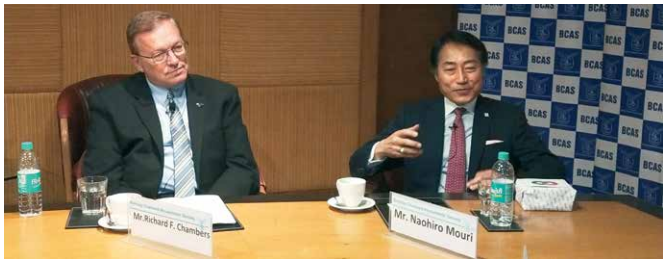Vivad se Vishwas sections 2(1)(o) and 9(a)(ii) – Prosecution – Pending prosecution for assessment year in question on an issue unrelated to tax arrears – Holding that an assessee would not be eligible to file a declaration would defeat very purport and object of Vivad se Vishwas Act – Question No. 73 vide Circular No. 21/2020 dated 4th December, 2020 is not in consonance with section 9(a)(ii) of Vivad se Vishwas Act
The assessee is a public limited company engaged in the business of land development and construction of real estate properties. Initially, Shreeniwas Cotton Mills Private Limited (‘Cotton Mills’ for short) was a subsidiary of the assessee company. Subsequently, it was merged with the assessee company on the strength of the amalgamation scheme sanctioned vide order dated 7th June, 2019 passed by the National Company Law Tribunal, Mumbai Bench. The merger had taken place with effect from 1st April, 2018. However, the pending tax demand against the cotton mills under the Act continued in the name of the cotton mills since migration of the permanent account number of the cotton mills to the permanent account number of the assessee company had not taken place. Therefore, it is pleaded that the tax demand of the cotton mills should be construed to be that of the assessee company and reference to the assessee company would mean and include the assessee company as well as the cotton mills.
For the A.Y. 2015-16, the assessee had filed return of income u/s 139(1) disclosing total income of Rs. 2,05,71,01,650. The self-assessment income tax payable on the returned income as per section 115JB was Rs. 69,92,08,851. At the time of filing of the return, an amount of Rs. 27,34,77,755 was shown to have been paid by way of tax deducted at source. The balance of the self-assessment tax of Rs. 42,57,31,096 (Rs.69,92,08,851 less Rs. 27,34,77,755) with interest thereon under sections 234A, 234B and 234C aggregating to Rs. 12,36,74,855 (totalling Rs. 54,94,05,951) was paid by the assessee after the due date for filing of the return.
The Pr. CIT issued notice to the assessee on 19th September, 2017 to show cause as to why prosecution should not be initiated against it u/s 276-C(2) for alleged wilful attempt to evade tax on account of delayed payment of the balance amount of the self-assessment tax. The assessee in its reply denying the allegations, made a request to the Pr. CIT to withdraw the show cause notice. The assessee did not apply for compounding u/s 279(2).
In the meanwhile, on 17th December, 2017, the A.O. passed the assessment order for the A.Y. 2015-16 u/s 143(3). In this order, he disallowed certain expenses claimed by the assessee towards workmen’s compensation and other related expenses. After disallowing such claim, the A.O. computed the tax liability of the assessee at Rs. 61.75 crores, inclusive of interest.
When the aforesaid assessment order was challenged by the assessee, the Commissioner (Appeals) dismissed it and upheld the assessment order vide order dated 27th December, 2018.
Aggrieved by this order, the assessee preferred further appeal before the ITAT which is pending before the Tribunal for final hearing.
While the appeal of the assessee was pending before the Tribunal, the Central Government enacted the Direct Tax Vivad se Vishwas Act, 2020 which came into force on and from 17th March, 2020. The primary objective of this Act is to reduce pending tax litigations pertaining to direct taxes and in the process grant considerable relief to the eligible declarants while at the same time generating substantial revenue for the Government.
Circular No. 9 of 2020 dated 22nd April, 2020 was issued whereby certain clarifications were given in the form of questions and answers. The Central Government vide a Notification dated 18th March, 2020 has made the Vivad se Vishwas Rules.
With a view to settling the pending tax demand, the assessee submitted a declaration in terms of the Vivad se Vishwas Act on 23rd September, 2020 in the name of the cotton mills in respect of the tax dues for the A.Y. 2015-16 which is the subject matter of the appeal pending before the Tribunal.
While the assessee’s declaration dated 23rd September, 2020 was pending, it came to know that the Pr. CIT had passed an order on 3rd May, 2019 authorising the Joint Commissioner of Tax (OSD) to initiate criminal prosecution against the cotton mills and its directors by filing a complaint before the competent magistrate in respect of the delayed payment of self-assessment tax for the A.Y. 2015-16. On the basis of such sanction, the Income-tax Department filed a criminal complaint under section 276-C(2) r/w/s 278B before the 38th Metropolitan Magistrate’s Court at Ballard Pier. However, no progress has taken place in the said criminal case.
The impugned Circular No. 21/2020 dated 4th December, 2020 was issued giving further clarifications in respect of the Vivad se Vishwas Act. Question No. 73 contained therein is: when in the case of a taxpayer prosecution has been initiated for the A.Y. 2012-13 with respect to an issue which is not in appeal, would he be eligible to file declaration for issues which are in appeal for the said assessment year and in respect of which prosecution has not been launched? The answer given to this is that ineligibility to file declaration relates to an assessment year in respect of which prosecution has been instituted on or before the date of declaration. Since for the A.Y. 2012-13 prosecution has already been instituted, the taxpayer would not be eligible to file a declaration for the said assessment year even on issues not relating to prosecution.
It is the grievance of the assessee company that on the basis of the answer given to Question No. 73 its declaration would be rejected since the declaration pertains to the A.Y. 2015-16 and prosecution has been launched against it for delayed payment of self-assessment tax for the A.Y. 2015-16. It is in this context that the assessee approached the High Court by a writ petition seeking the reliefs as indicated above.
The High Court held that the exclusion referred to in section 9(a)(ii) is in respect of tax arrears relating to an assessment year in respect of which prosecution has been instituted on or before the date of filing of declaration. Thus, what section 9(a)(ii) postulates is that the provisions of the Vivad se Vishwas Act would not apply in respect of tax arrears relating to an assessment year in respect of which prosecution has been instituted on or before the date of filing of declaration. Therefore, the prosecution must be in respect of tax arrears relating to an A.Y. The Court was of the view that there is no ambiguity insofar as the intent of the provision is concerned and a statute must be construed according to the intention of the Legislature and that the Courts should act upon the true intention of the Legislature while applying and interpreting the law. Therefore, what section 9(a)(ii) stipulates is that the provisions of the Vivad se Vishwas Act shall not apply in the case of a declarant in whose case a prosecution has been instituted in respect of tax arrears relating to an assessment year on or before the date of filing of declaration. The prosecution has to be in respect of tax arrears which naturally is relatable to an assessment year.
The Court observed that a look at clauses (b) to (e) of section (9) shows that there is a clear demarcation in section 9 of the Act inasmuch as the exclusions provided under clause (a) are in respect of tax arrears, whereas in clauses (b) to (e) the thrust is on the person who is either in detention or facing prosecution under the special enactments mentioned therein. Therefore, if we read clauses (b) to (e) of section 9, it would be apparent that such categories of persons would not be eligible to file a declaration under the Vivad se Vishwas Act in view of their exclusion in terms of section 9(b) to (e).
Apart from this, the Court observed that under the scheme of the Act and the purpose of the Rules as a whole, the basic thrust is on settlement in respect of tax arrears. Under section 9 certain categories of assessees are excluded from availing the benefit of the Vivad se Vishwas Act. While those persons who are facing prosecution under serious charges or those who are in detention as mentioned in clauses (b) to (e) are excluded, the exclusion under clause (a) is in respect of tax arrears which is further circumscribed by sub-clause (ii) to the extent that if prosecution has been instituted in respect of tax arrears of the declarant relating to an A.Y. on or before the date of filing of declaration, he would not be entitled to apply under the Vivad se Vishwas Act. Now, tax arrears has a definite connotation under the Vivad se Vishwas Act in terms of section 2(1)(o) which has to be read together with sections 2(f) to 2(j).
Further, the High Court held that to say that the ineligibility u/s 9(a)(ii) relates to an assessment year and if for that assessment year a prosecution has been instituted, then the taxpayer would not be eligible to file declaration for the said A.Y. even on issues not relating to prosecution, would not only be illogical and irrational but would be in complete deviation from section 9(a)(ii) of the Act. Such an interpretation would do violence to the plain language of the statute and, therefore, cannot be accepted. On a literal interpretation or by adopting a purposive interpretation of section 9(a)(ii), the only exclusion visualised under the said provision is pendency of a prosecution in respect of tax arrears relatable to an assessment year as on the date of filing of declaration and not pendency of a prosecution in respect of an A.Y. on any issue. The debarment must be in respect of the tax arrears as defined u/s 2(1)(o) of the Vivad se Vishwas Act. Therefore, to hold that an assessee would not be eligible to file a declaration because there is a pending prosecution for the A.Y. in question on an issue unrelated to tax arrears would defeat the very purport and object of the Act. Such an interpretation which abridges the scope of settlement as contemplated under the Act cannot, therefore, be accepted.
Insofar as the prosecution against the petitioner is concerned, the same has been initiated u/s 276C(2) because of the delayed payment of the balance amount of the self-assessment tax. Such delayed payment cannot be construed to be a tax arrear within the meaning of section 2(1)(o). Therefore, such a prosecution cannot be said to be in respect of tax arrears. Since such a prosecution is pending which is relatable to the A.Y, 2015-16, it would be in complete defiance of logic to debar the petitioner from filing a declaration for settlement of tax arrears for the said A.Y. which is pending in appeal before the Tribunal.
Considering the above, the clarification given by way of answer to Question No. 73 vide Circular No. 21/2020 dated 4th December, 2020 is not in consonance with section 9(a)(ii) of the Vivad se Vishwas Act and, therefore, the same would stand to be set aside and quashed. The declaration of the petitioner dated 23rd September, 2020 was directed to be decided by the Pr. CIT in conformity with the provisions of the Vivad se Vishwas Act dehors the answer given to Question No. 73 which was set aside and quashed. The writ petition was allowed.









